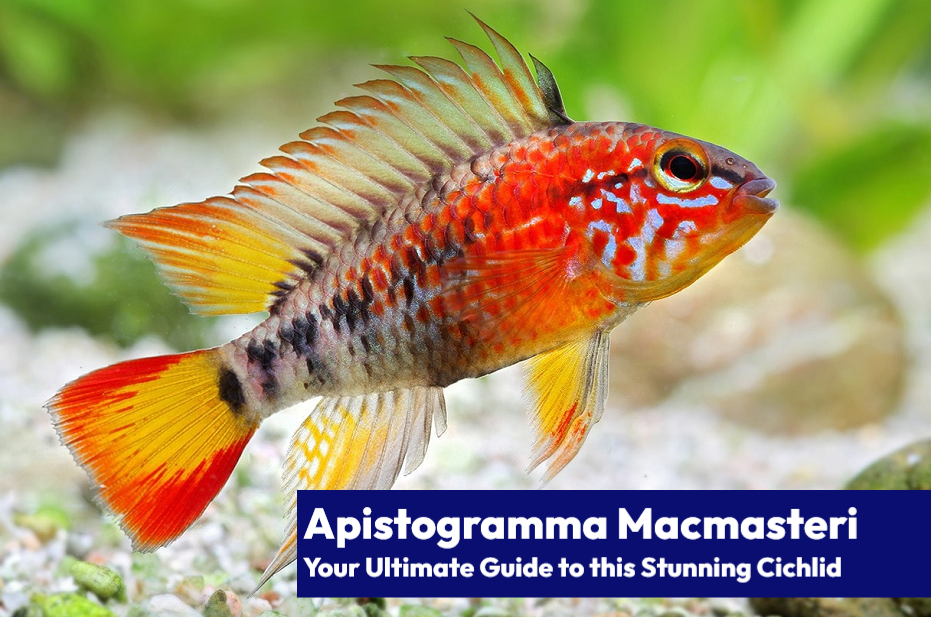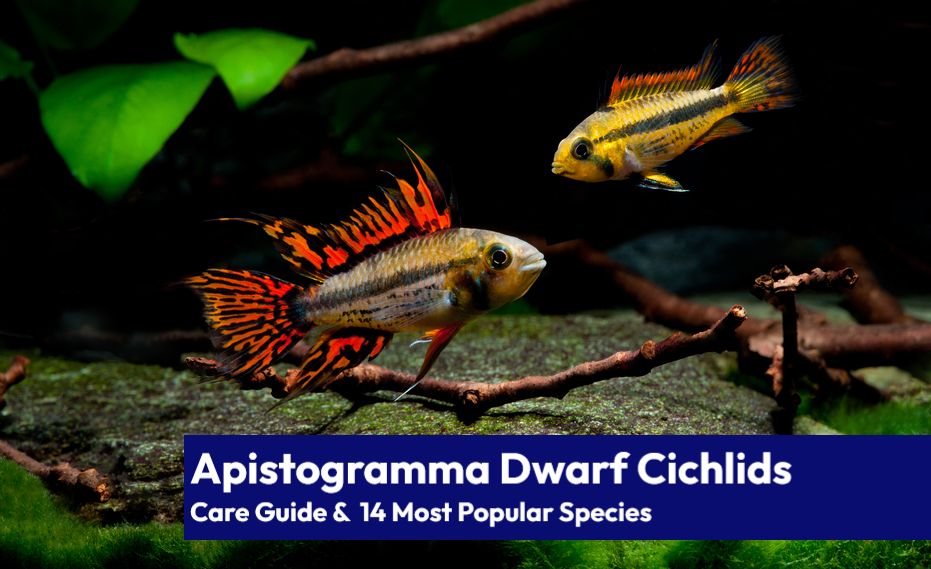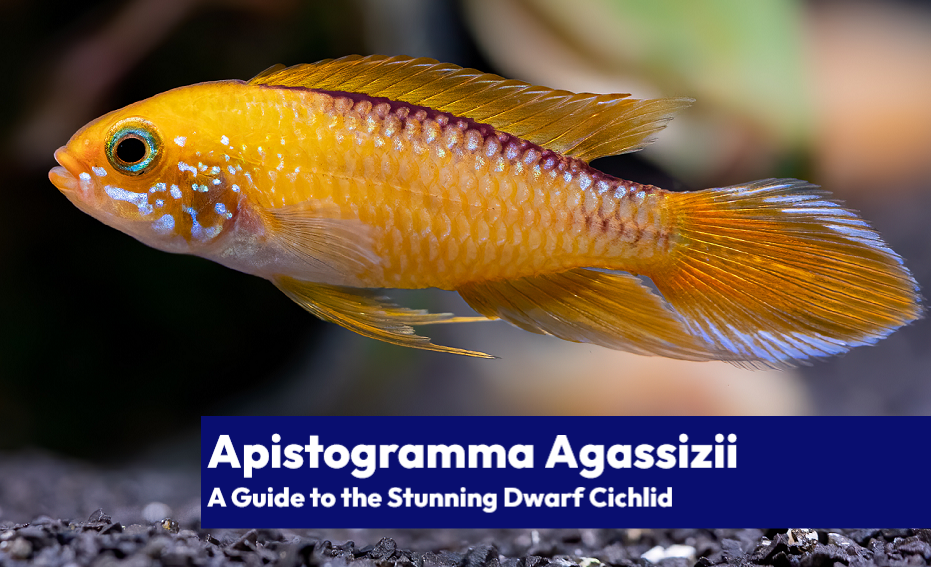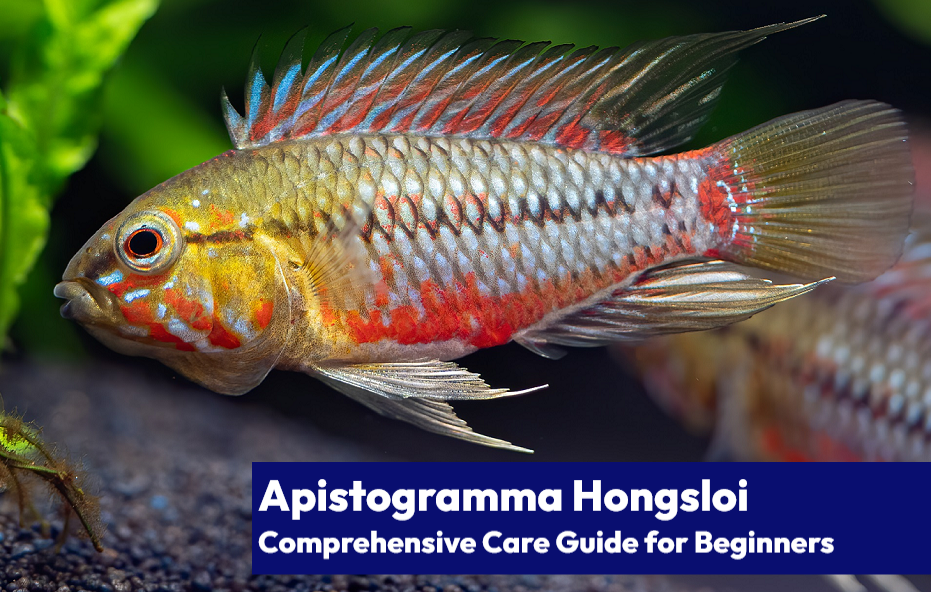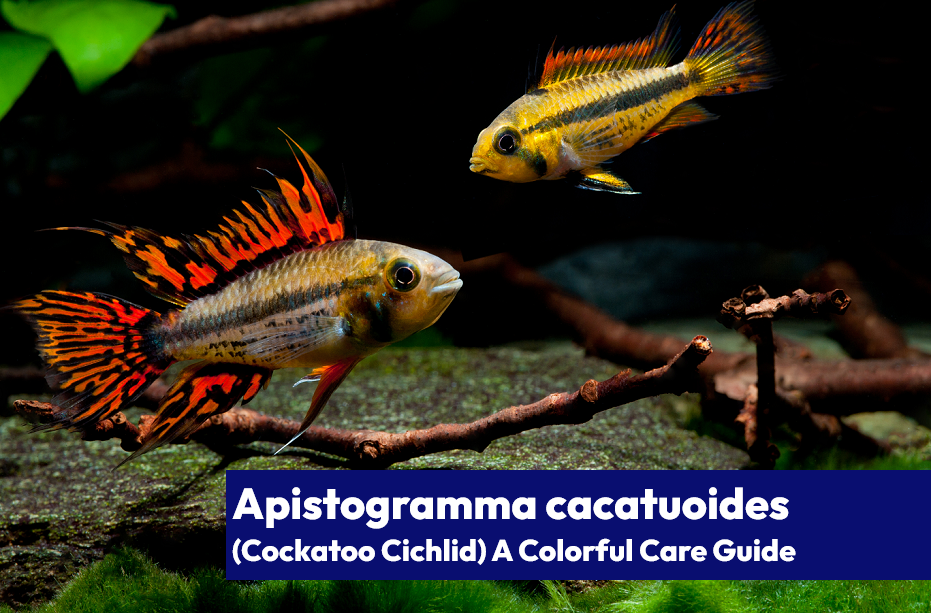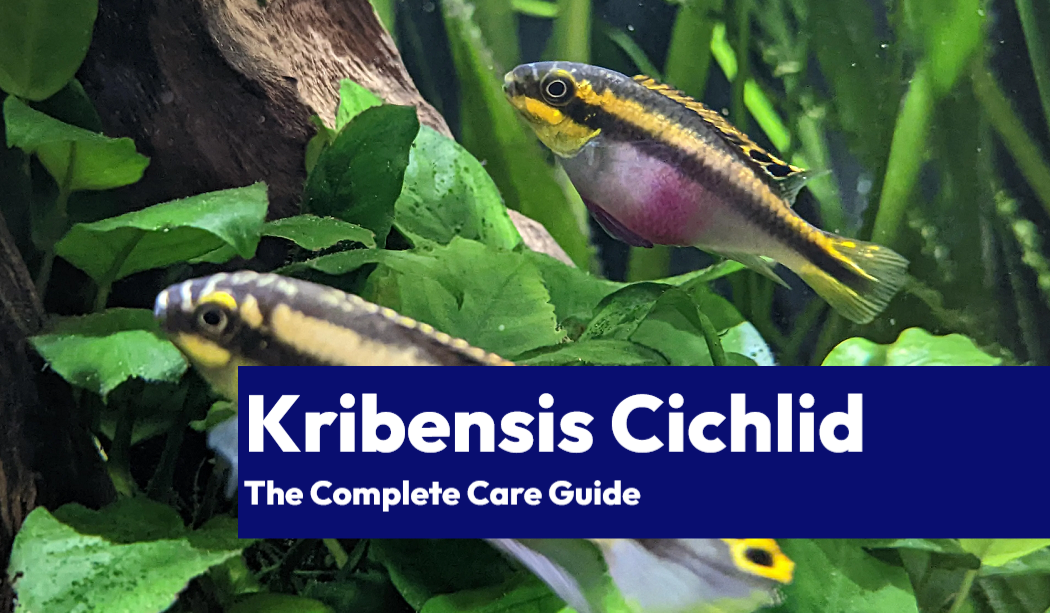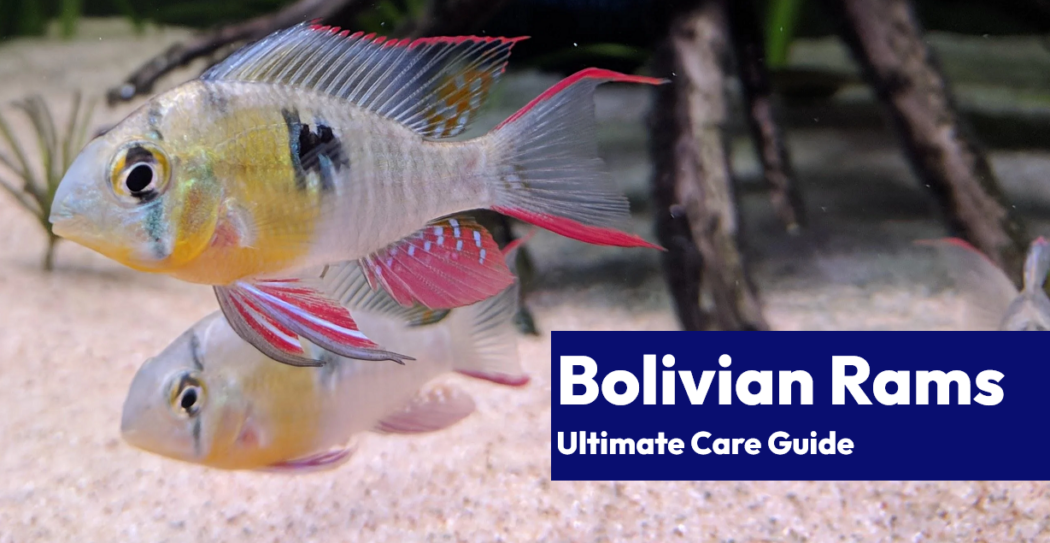Greetings, fellow fish fanatics! I’m Tim Priest, and today we’re diving into the enchanting world of the Apistogramma macmasteri. Trust me, this little fish is nothing short of pure magic. So, buckle up, and let’s explore the colorful realm of this captivating cichlid!
A Macmasteri Masterclass 🎓
Apistogramma macmasteri, or the Macmaster’s dwarf cichlid, is an absolute stunner in the aquarium hobby world. With its vibrant colors and feisty temperament, it’s no wonder this little fish has captured the hearts of many aquarists. But before we delve into the nitty-gritty, let’s get the lowdown on some essential A. macmasteri care data.
| Care Data | Apistogramma macmasteri |
|---|---|
| Scientific Name | Apistogramma macmasteri |
| Type | Dwarf Cichlid |
| Adult Size | 3.5 inches (8.9 cm) |
| Tank Size | 20 gallons (76 liters) |
| Optimal Temperature | 75-82°F (24-28°C) |
| General Hardness | 3-12 dGH (50-200 ppm) |
| Carbonate Hardness | 2-5 dKH (35-90 ppm) |
| Optimal pH Range | 5.0-7.0 |
| Diet Type | Omnivore |
| Feeding Frequency | Twice daily |
| Water Change Frequency | Weekly |
| Can Breed In Captivity? | Yes |
| Number of Fry (if applicable) | 30-80 |
| Spawning Type | Substrate Spawner |
| Native Range | South America (Colombia, Venezuela) |
| Temperament | Semi-aggressive |
| Schooling/Shoaling Fish | No |
| Can Jump Out Of Tank? | No |
| Average Cost (USD) | $10-20 |
A Dazzling Display of Colors 🌈

The Apistogramma macmasteri is a visual treat, boasting a stunning mix of colors and patterns. Males are particularly impressive, with their bold yellow, red, and blue hues, while females are a bit more subdued, usually showcasing yellow tones with dark stripes. But wait, there’s more…
Let’s Talk About Sexual Dimorphism, Baby 🕺💃
In the world of A. macmasteri, males and females aren’t just different in color—they’re also different in size and fin shape. Males are larger, with elongated dorsal and caudal fins, while females are smaller and have shorter fins. So, telling them apart? Easy peasy!
How Big and Fast Do They Grow? 📏🚀
Apistogramma macmasteri reaches an adult size of about 3.5 inches (8.9 cm) long. Their growth rate depends on factors such as diet, water quality, and tank conditions. Generally, they grow at a moderate pace, reaching their adult size within 9-12 months.
The Age of Apistogramma: Lifespan Wonders ⏳
You can expect your Apistogramma macmasteri to live a fulfilling life of around 3-5 years, with some even making it to the ripe old age of 7 under ideal conditions. So, if you’re looking to add a long-term finned friend to your aquatic family, these little guys might be just the ticket!
💡 Pro Tip: Providing a balanced diet, maintaining stable water parameters, and offering a stress-free environment can help your A. macmasteri live a longer and healthier life.
Tank Size: Room to Roam 🏡
Apistogramma macmasteri requires a minimum tank size of 20 gallons (76 liters). While they aren’t schooling fish, they do enjoy the company of their own kind. A 20 gallon tank provides ample space for a small group of A. macmasteri and some compatible tankmates.

Water Parameters: The Comfort Zone 💧
To keep your Apistogramma macmasteri happy and healthy, aim for water parameters within these ranges:
- Temperature: 75-82°F (24-28°C)
- pH: 5.0-7.0
- General Hardness: 3-12 dGH (50-200 ppm)
- Carbonate Hardness: 2-5 dKH (35-90 ppm)
Always remember, stable water parameters are key to ensuring your A. macmasteri thrive!
Diet: A Smorgasbord of Delights 🍽️
Apistogramma macmasteri are omnivores, so their ideal diet includes a mix of meaty and plant-based foods. Here are some great options for keeping your A. macmasteri happy and healthy:
- High-quality flakes or pellets
- Frozen or live brine shrimp
- Daphnia
- Bloodworms
- Mysis shrimp
- Vegetables like spinach, zucchini, or peas
- Crushed algae wafers
Feed your A. macmasteri twice daily, but remember, moderation is key. Overfeeding can lead to health issues and poor water quality.
Habitat Requirements: Home Sweet Home 🌿
Your Apistogramma macmasteri will appreciate a tank that replicates their natural habitat. Include plenty of hiding spots, such as caves, rocks, and driftwood. Plants like Java fern, Anubias, and Amazon sword plants will also help make your A. macmasteri feel right at home.
💡 Important: Soft, tannin-rich water is ideal for A. macmasteri. Adding Indian almond leaves or peat moss to your aquarium can help achieve this.
Behavior and Temperament: A Dash of Sass 🎭
While not overly aggressive, Apistogramma macmasteri can be territorial, especially during breeding. Males may display dominance towards other males, but overall, these feisty fish can coexist peacefully with other tankmates.
💡 Fun Fact: Did you know that female A. macmasteri sometimes change color to mimic males when they’re trying to avoid unwanted attention? Clever girls!
Tankmates: Friends and Foes 🤝
When it comes to tankmates, choose wisely. Here are some ideal companions for your Apistogramma macmasteri:
- Neon tetras
- Ember tetras
- Harlequin rasboras
- Rummy-nose tetras
- Pygmy corydoras
- Otocinclus catfish
- Hatchetfish
- Dwarf gouramis
- Kuhli loaches
- Bolivian rams
- Pencilfish
- Cherry barbs
But watch out! Avoid these bad tankmates, as they may cause trouble:
- Large, aggressive cichlids
- Oscar fish
- Arowanas
- Red-tailed sharks
- Tiger barbs
- Jack Dempseys
- Flowerhorns
Remember, compatibility is key to a harmonious tank community.
Breeding: The Miracle of Life 🐣
Breeding Apistogramma macmasteri can be a rewarding experience. Providing optimal water parameters, hiding spots, and a balanced diet will encourage spawning. The female will lay eggs on a flat surface, and after hatching, she’ll guard the fry until they’re ready to fend for themselves.
Hybrids, Variants, and Morphs: The Art of Diversity 🎨
There are several morph variations of Apistogramma macmasteri, including “Super Red”, “Red Neck”, and “Gold”. Each of their stunning colors and patterns make them unique and beautiful additions to any tank.
💡 Expert Tip: Be careful when buying A. macmasteri online, as they’re sometimes confused with other Apistogramma species. Make sure you’re purchasing from a reputable seller.
Diseases and Illnesses: Prevention and Cure 🏥
Apistogramma macmasteri is susceptible to common fish diseases, such as:
- Ich: Treat with Seachem Paraguard or Hikari Ich-X.
- Fin Rot: API Melafix is an effective treatment.
- Internal Parasites: Use Seachem Metroplex to combat these pesky invaders.
Remember, prevention is better than cure—maintain excellent water quality and avoid stressors to keep your A. macmasteri healthy.
Origin and Native Range: South American Wonders 🌎
Apistogramma macmasteri hails from the rivers and streams of Colombia and Venezuela. Their natural habitat is characterized by soft, tannin-rich water and plenty of aquatic vegetation.
Taxonomy: Family Ties 👪
Apistogramma macmasteri is closely related to other Apistogramma species in the aquarium hobby, such as Apistogramma cacatuoides and Apistogramma agassizii. Here’s their full taxonomy:
| Rank | Name |
|---|---|
| Kingdom | Animalia |
| Phylum | Chordata |
| Class | Actinopterygii |
| Order | Cichliformes |
| Family | Cichlidae |
| Genus | Apistogramma |
| Species | A. macmasteri |
Wrapping Up: Apistogramma Macmasteri Magic ✨
Well, there you have it! Everything you need to know about the enchanting Apistogramma macmasteri. These little gems are perfect for adding a splash of color and personality to your aquarium. Just remember to provide a suitable environment, compatible tankmates, and a balanced diet to keep your A. macmasteri happy and thriving.
TL;DR:
- Apistogramma macmasteri: colorful, feisty dwarf cichlids
- Adult size: 3.5 inches (8.9 cm); lifespan: 3-5 years
- Minimum tank size: 20 gallons (76 liters)
- Water parameters: soft, acidic, and tannin-rich
- Diet: omnivorous; feed a mix of meaty and plant-based foods
- Good tankmates: small, peaceful fish; avoid large or aggressive species
- Can breed in captivity under optimal conditions

Tim Priest, a renowned aquarium expert with over 15 years of experience in aquatic gardening and fish education, is dedicated to helping enthusiasts create stunning and thriving aquatic environments. As the founder of LearnTheAquarium.com, Tim shares his wealth of knowledge, passion, and expertise through engaging articles, educational resources, and personalized advice.
Discover the secrets to creating captivating underwater landscapes and maintaining healthy aquatic ecosystems. Join Tim on an exciting journey and let your aquarium adventure begin!
